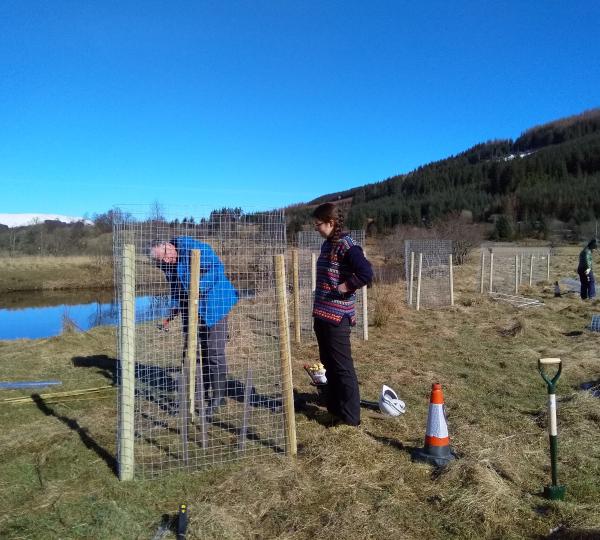Stroneslaney Farm Riparian Tree Planting Projects main aim was to boost riparian trees along the River Balvaig within the floodplain. Currently, the river lacks riparian tree cover which is suspected to be due to deer populations and livestock limiting natural regeneration in the area. This means that there is a lack of new trees growing to fill the gaps of older trees coming to the end of their life along the river. There is large sections of the river which do not have sufficient riparian trees to provide benefits such as cover and shade for fish species and habitat for birds and insects or slow the flow during flooding. The lack of trees is also making the river more susceptible to erosion with very shallow root structures holding the river banks together.
To support the river, riparian corridor and wildlife the Forth Rivers Trust worked alongside one landowner to boost riparian trees along the river in a field used by grazing cattle.
The project planted 500 trees along the river in two different types of enclosure, due to the field being used for cattle, any tree protection measure needs to withstand cattle grazing. The below options have been used to protect trees in cattle fields previously by the Trust and plan to be used as part of this project.
Triangle enclosures – there is 50 small triangle enclosures similar to the picture which has been submitted with this application. These enclosures would each hold 8 trees and would be in the shape of a triangle. The enclosure consists of 3 2m long stakes hammered into the ground leaving 1.65m above with each side being roughly 1-1.5m long. The trees would then be planted in the enclosure and wire mesh wrapped around to provide protection from livestock and deer. These enclosures would be positioned with the point of the triangle pointing upstream, this is to try and minimise any large debris getting stuck on the enclosure, hopefully being diverted around its sides. The enclosures will be spread out between the core planting areas highlighted in the attached map and where the river banks are most vulnerable.
Agro-forestry enclosure - between each core planting zone, trees will be planted at a lower density (roughly 2/3metres apart) and will consist of a small cylinder-shaped enclosure consisting of two 2 metre fence posts hammered into the ground leaving 1.7m above ground. one or two trees will be planted in each enclosure with wire mesh wrapped around to provide protection. This method has been used by Forestry Commission when protecting against livestock.
Within each type of enclosure, a small spiral tree guard will also be used to protect against voles and rabbits.
Funding was secured through the Loch Lomond & Trossachs National Park Heritage Grant Scheme to deliver the works on the ground and volunteers helped construct the enclosures and plant the trees.

